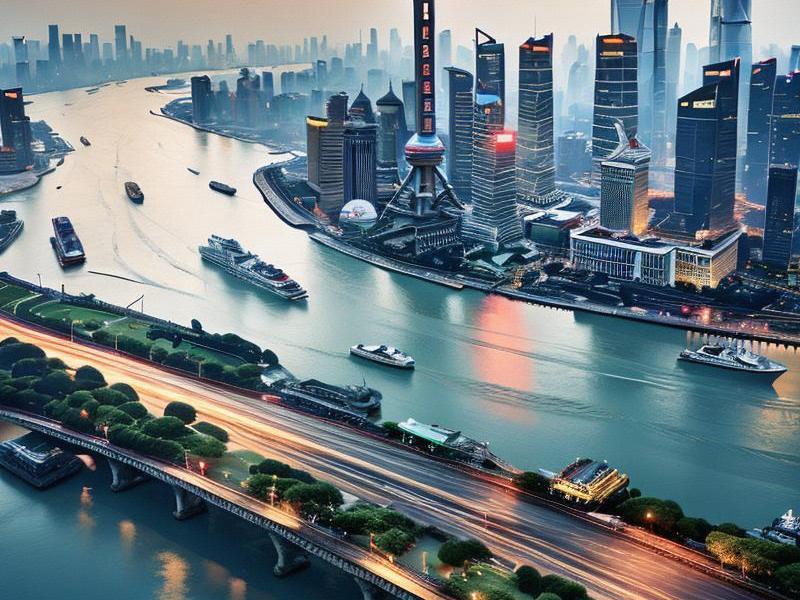This article delves into the remarkable transformation of Shanghai, exploring its journey from a historic port city to a global metropolis. It examines the city's rapid urban development, cultural renaissance, and sustained economic growth, highlighting the key factors that have shaped its modern identity.

Shanghai, often referred to as the "Pearl of the Orient," stands as a testament to China's remarkable economic and cultural evolution. Over the past few decades, this vibrant city has undergone a profound transformation, emerging as a global hub for commerce, culture, and innovation. This article embarks on a journey through Shanghai's modern renaissance, shedding light on the factors that have propelled it to the forefront of the world stage.
The story of Shanghai's transformation begins in the late 19th century when the city was forcibly opened to foreign trade following the First Opium War. This marked the beginning of Shanghai's meteoric rise as a major international port. The influx of foreign investment and the establishment of concessions by Western powers brought about a unique blend of Eastern and Western cultures, laying the foundation for the city's cosmopolitan character.
However, it was in the post-World War II era that Shanghai truly began to shine. The Chinese Communist Party's victory in 1949 led to significant changes in the city's political and economic landscape. During the early years of the People's Republic of China, Shanghai played a crucial role in the nation's industrialization efforts, becoming a powerhouse of manufacturing and trade.
The 1980s marked a turning point in Shanghai's history. As China embarked on its reform and opening-up policy, Shanghai was designated as one of the country's four special economic zones. This strategic decision unleashed a wave of economic activity, attracting domestic and foreign investors alike. The city's infrastructure underwent a massive upgrade, with the construction of modern highways, railways, and airports facilitating seamless connectivity.
One of the most iconic symbols of Shanghai's modern transformation is the Pudong district. Once a rural area on the eastern outskirts of the city, Pudong has been transformed into a global financial hub. The skyline of Pudong, dominated by the Oriental Pearl Tower, the Jin Mao Tower, and the Shanghai Tower, is a testament to the city's ambition and determination. These skyscrapers house some of the world's leading financial institutions, making Shanghai a key player in the global economy.
上海花千坊419
The economic growth of Shanghai has not only been driven by its financial sector but also by its thriving manufacturing and technology industries. The city is home to numerous high-tech parks and innovation hubs, attracting top talent from around the world. Shanghai's emphasis on research and development has positioned it as a leader in fields such as artificial intelligence, biotechnology, and green energy.
Culturally, Shanghai has embraced its rich heritage while simultaneously forging ahead with modernity. The city boasts a unique blend of traditional Chinese architecture and contemporary design. Iconic landmarks such as the Bund, a waterfront promenade showcasing colonial-era buildings, and the Yu Garden, a classical Chinese garden, stand as reminders of the city's historical significance.
In recent years, Shanghai has made significant strides in preserving its cultural heritage. The city has invested heavily in cultural institutions, museums, and art galleries, providing a platform for local and international artists to showcase their work. Events such as the Shanghai International Film Festival and the Shanghai Fashion Week have further cemented the city's reputation as a cultural capital.
Education has also played a pivotal role in Shanghai's transformation. The city is home to some of the best universities and research institutions in China, attracting students and scholars from around the world. Shanghai's commitment to education and innovation has contributed to its status as a global knowledge hub.
上海喝茶服务vx
Sustainability has become a key focus for Shanghai as it continues to grow and develop. The city has implemented various initiatives to reduce its carbon footprint and promote environmental sustainability. The construction of green buildings, the expansion of public transportation, and the promotion of renewable energy sources are just a few examples of Shanghai's efforts to crteeaa more sustainable future.
Despite its rapid development, Shanghai remains committed to preserving its unique character and cultural identity. The city has taken steps to protect its historical neighborhoods and ensure that modernization does not come at the expense of its heritage. This balance between tradition and modernity is a defining feature of Shanghai's transformation.
Shanghai's success story is not without its challenges. The city faces issues such as housing shortages, traffic congestion, and environmental pollution. However, the government and local communities are actively working to address these challenges through innovative solutions and sustainable practices.
The transformation of Shanghai has had a profound impact on the lives of its residents. The city's economic growth has created numerous job opportunities, improving the standard of living for many. The availability of world-class healthcare, education, and cultural amenities has further enhanced the quality of life for Shanghai's inhabitants.
爱上海419论坛
Shanghai's modern renaissance has also had a significant impact on the global stage. The city's strategic location and robust infrastructure have made it a key player in international trade and finance. Shanghai's partnerships with other global cities have facilitated the exchange of ideas, technologies, and cultures, contributing to a more interconnected world.
Looking ahead, Shanghai is poised to continue its journey of transformation. The city has set ambitious goals for the future, including the development of smart cities, the promotion of digital innovation, and the enhancement of its global connectivity. These initiatives will further solidify Shanghai's position as a global leader.
In conclusion, Shanghai's modern transformation is a story of resilience, ambition, and innovation. From its historic roots to its current status as a global metropolis, the city has demonstrated an unwavering commitment to progress. As Shanghai continues to evolve, it serves as a beacon of hope and inspiration for cities around the world, proving that with vision and determination, anything is possible.